Pulmonary Embolism in A Patient with Superficial Thrombophlebitis ...
Pulmonary Embolism in A Patient with Superficial Thrombophlebitis ...
Pulmonary Embolism in A Patient with Superficial Thrombophlebitis ...
Create successful ePaper yourself
Turn your PDF publications into a flip-book with our unique Google optimized e-Paper software.
Case Report<br />
Acta Cardiol S<strong>in</strong> 2004;20:2414<br />
<strong>Pulmonary</strong> <strong>Embolism</strong> <strong>in</strong> A <strong>Patient</strong> <strong>with</strong> <strong>Superficial</strong><br />
<strong>Thrombophlebitis</strong> ReportofACase<br />
Wei-Sh<strong>in</strong> Liu 1 and B<strong>in</strong>g-Hsiean Tzeng 2<br />
A 62-year-old woman presented <strong>with</strong> mild swell<strong>in</strong>g, pa<strong>in</strong>, and exercise <strong>in</strong>tolerance <strong>in</strong> the right lower limb for nearly<br />
a week; chest pa<strong>in</strong>, dyspnea, and palpitation also subsequently bothered her, and then she suffered 2 attacks of<br />
syncope, which prompted hospital admission. Acute coronary syndrome was our impression at first, but emergent<br />
coronary angiography did not support this diagnosis. An acute pulmonary embolism was then diagnosed based on<br />
the cl<strong>in</strong>ical presentation, laboratory data, and imag<strong>in</strong>g f<strong>in</strong>d<strong>in</strong>gs. Duplex scan of the right lower limb revealed diffuse<br />
thrombosis of the great saphenous ve<strong>in</strong> from the saphenous-femoral junction to the level of the knee; the thrombosis<br />
was <strong>in</strong>compressible. However, there was no evidence of deep-ve<strong>in</strong> thrombosis. We supposed that superficial<br />
thrombophlebitis might have been the possible etiology of her pulmonary embolism, and suggest that pulmonary<br />
embolism may be concurrent <strong>in</strong> patients <strong>with</strong> varicose ve<strong>in</strong>s and superficial thrombophlebitis.<br />
Key Words:<br />
Varicose ve<strong>in</strong>s <strong>Superficial</strong> thrombophlebitis <strong>Pulmonary</strong> embolism Acute coronary<br />
syndrome<br />
INTRODUCTION<br />
A diagnosis of pulmonary embolism (PE) is often<br />
delayed, especially <strong>in</strong> patients <strong>with</strong> no significant predispos<strong>in</strong>g<br />
factors. <strong>Pulmonary</strong> embolism rarely orig<strong>in</strong>ates<br />
from superficial thrombophlebitis (STP). 1 This is because<br />
venous wall <strong>in</strong>flammation causes adherence of the<br />
thrombus. Furthermore, diameters of the superficial<br />
ve<strong>in</strong>s are smaller than those of the deep ve<strong>in</strong>s, thus even<br />
though PE takes place, it usually does not <strong>in</strong>duce significant<br />
cl<strong>in</strong>ical symptoms. We report on a patient <strong>with</strong> an<br />
acute pulmonary embolism, who was misdiagnosed as hav<strong>in</strong>g<br />
acute coronary syndrome; STP was the likely etiology.<br />
Received: December 26, 2003 Accepted: March 24, 2004<br />
1 Division of Cardiology, Buddhist Tsu-Chi General Hospital, Hualien,<br />
2 Division of Cardiology, Tri-Service General Hospital, Taipei, Taiwan.<br />
Address correspondence and repr<strong>in</strong>t requests to: Dr. B<strong>in</strong>g-Hsiean<br />
Tzeng, Division of Cardiology, Tri-Service General Hospital, 325,<br />
Sec. 2, Cheng-Kung Road, Nei-Hu, Taipei 114, Taiwan.<br />
Tel: 886-2-8792-7160; Fax: 886-2-8792-7161;<br />
E-mail: bhtzeng@gcn.net.tw<br />
CASE REPORT<br />
A 62-year-old woman visited our medical emergency<br />
room <strong>with</strong> the chief compla<strong>in</strong>t of syncope twice <strong>in</strong> a day.<br />
By trac<strong>in</strong>g back her history, she had suffered from mild<br />
swell<strong>in</strong>g, pa<strong>in</strong>, and exercise <strong>in</strong>tolerance <strong>in</strong> her right lower<br />
limb for nearly 1 week. Symptoms persisted, and chest<br />
pa<strong>in</strong>, palpitation, and dyspnea were noted <strong>in</strong> the follow<strong>in</strong>g<br />
days. She suffered 2 attacks of syncope thereafter, and she<br />
was sent to our medical emergency room. Physical exams<br />
revealed tachypnea (25/m<strong>in</strong>), tachycardia (109 bpm), and<br />
clear bilateral breath<strong>in</strong>g sounds, and a grade II/VI<br />
holosystolic murmur was audible over the lower left sternal<br />
border. There were obvious varicose ve<strong>in</strong>s over the<br />
bilateral calves. Hard <strong>in</strong>durations along a varicose ve<strong>in</strong> of<br />
the right lower limb <strong>with</strong> tenderness were also found. Surface<br />
electrocardiogram (ECG) revealed s<strong>in</strong>us tachycardia,<br />
<strong>with</strong> an S wave <strong>in</strong> lead I, a Q wave <strong>in</strong> lead III, an <strong>in</strong>verted<br />
T wave <strong>in</strong> V1-4, and ST depression <strong>in</strong> V2-6 (Figure 1).<br />
Acute coronary syndrome (ACS) was our impression at<br />
first. Oral aspir<strong>in</strong> and <strong>in</strong>travenous hepar<strong>in</strong> and nitrite were<br />
adm<strong>in</strong>istered. However, coronary angiography revealed<br />
241 Acta Cardiol S<strong>in</strong> 2004;20:2414
Wei-Sh<strong>in</strong> Liu et al.<br />
Figure 1. Surface ECG at ER revealed s<strong>in</strong>us tachycardia, S wave <strong>in</strong> lead I, Q wave <strong>in</strong> lead III, <strong>in</strong>verted T wave <strong>in</strong> V1-4, ST depression <strong>in</strong> V2-6.<br />
<strong>in</strong>significant stenosis of around 50% at the first diagonal<br />
branch of the left anterior descend<strong>in</strong>g artery. The chest<br />
pa<strong>in</strong>, palpitation, and dyspnea persisted. The arterial<br />
blood gas showed a PaO 2 of 79 mmHg (under 40% FiO 2<br />
supplementation). Chest film revealed no specific f<strong>in</strong>d<strong>in</strong>gs.<br />
Echocardiography revealed dilatation of the right<br />
ventricle, moderate tricuspid regurgitation, <strong>with</strong> an estimated<br />
pulmonary arterial pressure of 40 mmHg, and no<br />
regional wall motion abnormality of the left ventricle.<br />
Perfusion and ventilation lung scans revealed multiple<br />
segmental and subsegmental perfusion defects <strong>in</strong> both<br />
lung fields (Figure 2A). The D-Dimer level was > 0.2<br />
ug/mL. A pulmonary embolism was impressed.<br />
The patient had no history of recent trauma or immobilization.<br />
Prote<strong>in</strong> C was 119% (60%~120% as normal),<br />
prote<strong>in</strong> S was 107% (60%~120% as normal), ant<strong>in</strong>uclear<br />
antibody was negative, anti-cardiolip<strong>in</strong> was 2.2 GPL U/mL<br />
(< 15 GPL U/mL as normal), and lupus anticoagulant was<br />
1.12 (<strong>with</strong> < 1.5 <strong>in</strong>dicat<strong>in</strong>g a weak presence as normal). A<br />
compressive duplex scan of the right lower limb (Figure 3)<br />
revealed a diffuse thrombosis of the right great saphenous<br />
ve<strong>in</strong> from the saphenous-femoral junction to the level of<br />
the knee jo<strong>in</strong>t; the thrombosis was <strong>in</strong>compressible. The<br />
femoral ve<strong>in</strong> was completely compressible <strong>with</strong> flow velocity<br />
of 24.5 cm/s (Figure 4). STP was the most likely<br />
etiology of the patient’s PE, although iliac ve<strong>in</strong> thrombosis<br />
could not be demostrated. A venogram was not performed<br />
because of her hypoxic condition.<br />
Intravenous hepar<strong>in</strong> <strong>in</strong>fusion <strong>with</strong> target activated<br />
prothromb<strong>in</strong> time of 46~70 seconds was <strong>in</strong>itiated. High li-<br />
Figure 2. (A) Initial lung perfusion scan revealed multiple segmental<br />
and subsegmental perfusion defects <strong>in</strong> both lung fields. (B) Lung<br />
perfusion scans 6 months later revealed normal f<strong>in</strong>d<strong>in</strong>gs.<br />
Acta Cardiol S<strong>in</strong> 2004;20:2414 242
<strong>Pulmonary</strong> <strong>Embolism</strong> and <strong>Superficial</strong> <strong>Thrombophlebitis</strong><br />
Figure 3. Duplex scan of right thigh revealed a thrombus (arrow) <strong>in</strong><br />
the great saphenous ve<strong>in</strong>, which was <strong>in</strong>compressible.<br />
patients. 3,5-7 In our patient, ACS was our impression at<br />
first, but it was not confirmed by coronary angiography.<br />
An echocardiogram is helpful <strong>in</strong> differentiat<strong>in</strong>g PE from<br />
ACS. In ACS, a regional wall motion abnormality can<br />
usually be found, while <strong>in</strong> PE, however, high pulmonary<br />
pressure and right ventricle dilatation <strong>with</strong><br />
dysfunction is found. Another concern was the etiology<br />
of our patient’s PE. Only varicose ve<strong>in</strong>s <strong>with</strong> superficial<br />
thrombophlebitis were found by duplex scan. A<br />
normal popliteal ve<strong>in</strong> and femoral ve<strong>in</strong> were documented<br />
by compressed duplex scan. The femoral ve<strong>in</strong> was completely<br />
compressible. Deep-ve<strong>in</strong> thrombosis was unlikely<br />
although iliac ve<strong>in</strong> thrombosis could not be identified.<br />
However, the patient’s condition improved after medication<br />
and high ligation at the saphenous-femoral junction.<br />
All present<strong>in</strong>g evidence suggested that superficial<br />
thrombophlebitis was the most likely etiology of her pulmonary<br />
embolism. The possible pathophysiology of her<br />
acute PE was dislodged thrombi from the STP of the<br />
great saphenous ve<strong>in</strong>. Her STP may have extended to the<br />
deep-ve<strong>in</strong> system via the saphenous-femoral junction or<br />
<strong>in</strong>competent perforat<strong>in</strong>g ve<strong>in</strong>s and thus <strong>in</strong>duced PE. 1,5<br />
Our experience suggests that STP might not always be<br />
benign and self-limit<strong>in</strong>g as previously described. The<br />
possibility that it can <strong>in</strong>duce a pulmonary embolism cannot<br />
be ignored.<br />
Figure 4. Duplex scan of femoral ve<strong>in</strong> revealed completely compressible,<br />
and the flow velocity was 24.5 cm/sec.<br />
gation of the right great saphenous ve<strong>in</strong> at the saphenousfemoral<br />
junction was performed the follow<strong>in</strong>g day. The<br />
patient was discharged asymptomatic 3 weeks later and<br />
was put on oral warfar<strong>in</strong>. Follow-up lung scans 6 months<br />
later revealed no evidence of PE (Figure 2B).<br />
DISCUSSION<br />
Verlato et al. reported an unexpectedly high rate<br />
33.3% (7 of 21 cases) of PE <strong>in</strong> patients <strong>with</strong> STP of the<br />
thigh, although cl<strong>in</strong>ical symptoms were present <strong>in</strong> only 1<br />
patient. 2 Whether STP alone produces PE is still controversial,<br />
3,4 however, previous research revealed that STP<br />
may extend to the deep venous system <strong>in</strong> 8.6% to 40% of<br />
REFERENCES<br />
1. Belcaro G, Nicolaides AN, Stansby G. The Venous Cl<strong>in</strong>ic. London:<br />
Imperial College Press, 1998:52-7.<br />
2. Verlato F, Zucchetta P, Prandoni P, et al. An unexpectedly high rate of<br />
pulmonary embolism <strong>in</strong> patient <strong>with</strong> superficial thrombophlebitis of<br />
the thigh. J Vasc Surg 1999;30:1113-5.<br />
3. Ascer E, Loresen E, Poll<strong>in</strong>a RM, et al. Prelim<strong>in</strong>ary results of a<br />
non-operative approach to saphena femoral junction thrombophlebitis.<br />
J Vasc Surg 1995;22:616-21.<br />
4. Blumemberg RM, Barton E, Gelfand ML, et al. Occult deep ve<strong>in</strong><br />
thrombosis complicat<strong>in</strong>g superficial thrombophlebitis. JVasc<br />
Surg 1998;27:338-43.<br />
5. Bounameaux H, Reber-Wasem MA. <strong>Superficial</strong> thrombophlebitis<br />
and deep ve<strong>in</strong> thrombosis. Arch Intern Med 1997;157:1822-4.<br />
6. Kesteven P. <strong>Superficial</strong> thrombophlebitis followed by pulmonary<br />
embolism. J R Soc Med 2001;94:186-7.<br />
7. Jorgensen JO, Hamel KC, Morgan AM, et al. The <strong>in</strong>cidence of deep<br />
venous thrombosis <strong>in</strong> patients <strong>with</strong> superficial thrombophlebitis of<br />
the lower limbs. J Vasc Surg 1993;18:70-3.<br />
243 Acta Cardiol S<strong>in</strong> 2004;20:2414
Case Report<br />
Acta Cardiol S<strong>in</strong> 2004;20:241−4<br />
表 淺 靜 脈 栓 塞 性 靜 脈 炎 患 者 之 肺 栓 塞 ⎯ 一 病 例 報 告<br />
劉 維 新 曾 炳 憲 *<br />
花 蓮 市 慈 濟 醫 院 心 臟 內 科<br />
台 北 市 三 軍 總 醫 院 心 臟 內 科 *<br />
一 位 六 十 二 歲 女 性 從 一 週 前 右 腿 開 始 有 輕 微 腫 痛 及 無 法 久 站 或 走 遠 的 現 象 , 其 後 數 日 又 有<br />
胸 痛 、 呼 吸 困 難 及 心 悸 。 之 後 因 昏 厥 送 入 本 院 急 診 。 最 初 診 斷 為 急 性 冠 心 症 但 心 導 管 排 除<br />
之 。 由 臨 床 症 狀 , 實 驗 室 及 影 像 學 檢 查 診 斷 肺 栓 塞 。 右 下 肢 的 都 普 勒 超 音 波 掃 瞄 顯 示 並 無<br />
深 部 靜 脈 栓 塞 , 然 而 卻 發 現 在 大 隱 靜 脈 從 膝 關 節 附 近 到 股 靜 脈 交 界 處 有 栓 塞 性 靜 脈 炎 。 經<br />
大 隱 靜 脈 結 紮 及 抗 凝 劑 治 療 後 , 其 症 狀 改 善 。 六 個 月 後 之 肺 部 掃 瞄 顯 示 正 常 。 我 們 認 為 其<br />
肺 栓 塞 最 可 能 的 原 因 是 由 表 淺 靜 脈 栓 塞 性 靜 脈 炎 所 引 起 , 並 建 議 靜 脈 曲 張 合 併 表 淺 靜 脈 炎<br />
之 病 患 須 考 慮 併 發 肺 栓 塞 之 可 能 性 。<br />
關 鍵 詞 : 靜 脈 曲 張 、 表 淺 靜 脈 栓 塞 性 靜 脈 炎 、 肺 栓 塞 、 深 部 靜 脈 栓 塞 。<br />
244




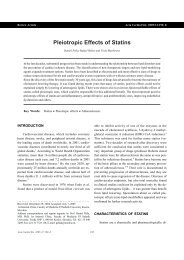
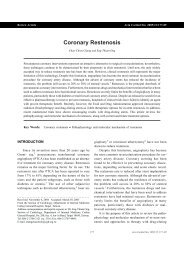
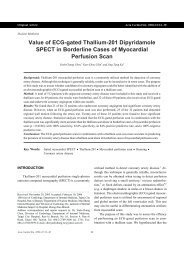

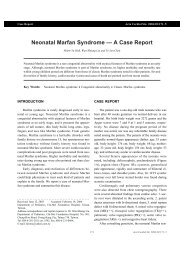
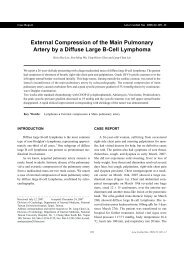




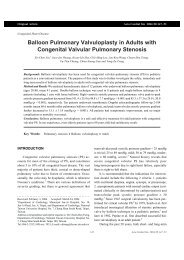
![Full Text [Download PDF]](https://img.yumpu.com/22999153/1/190x260/full-text-download-pdf.jpg?quality=85)